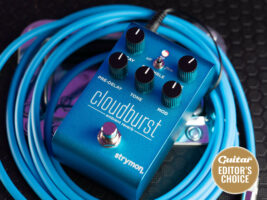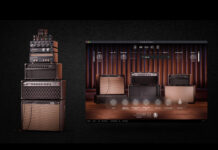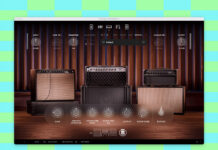
Strymon Cloudburst review: a new standard for ambient reverb pedals?
It’s hard to imagine a time before the vast majority of professional guitar players (and indeed many non-pros) had at least one Strymon pedal on their pedalboard, but in truth the company’s algorithmic revolution has been relatively rapid for a company that has only been around for just over a decade.
READ MORE: Strymon BlueSky V2 review – the reigning champ rises to the competition
Most pedal obsessives will be aware of the Strymon legend by now, but in the early 2000s former Line 6 engineers Pete Celi, Gregg Stock, Dave Freuhling and Terry Burton decided to work together on making something different for a boutique effects world that was, at the time, purely analog. Naming their nascent company Damage Control, the boffins produced some well-reviewed effects, including a series of tube-driven drive pedals and, in a hint of things to come, some clever high-end DSP pedals including a ‘multi-dimensional’ delay pedal known as the TimeLine.
Fast forward to 2009 and with Damage Control’s sales not living up to expectations, the company decided to rebrand the whole shooting match as Strymon and focus on unlocking the power of DSP in high-end stompboxes. Within a few years, the new brand and the new direction had paid off with the fidelity and musicality of pedals such as the BlueSky, Deco, TimeLine, BigSky and more making the brand one of the biggest success stories in modern effects.
Which brings us to the Cloudburst; a brand new pedal that has been causing waves in guitar culture for several reasons. Firstly, it’s a totally new form-factor for Strymon – a unique compact form factor that brings Strymon’s innovative and unique approach to DSP into its smallest footprint yet. Secondly, it’s a brand new ambient reverb pedal – the genre that, through the BlueSky and BigSky, catapulted the brand into the stratosphere.
Which is to say that a lot is riding on the Cloudburst, but Strymon hasn’t pulled any punches under the hood. The pedal carries a new ARM-based processor (previously seen on the updated V2 BlueSky amongst others) that promises the ability to produce everything from subtle ambience to lush, string-like pads and soundscapes, while also offering everything a modern effects obsessive could want; USB-C connectivity for MIDI and updates, stereo outputs, and a relatively non-thirsty 250mA current draw.
In use
The most noticeable thing about Cloudburst when you take it out of the box is the size – compared to the usual dimensions we’re used to seeing from the brand’s pedals it really is impressively small, especially when you consider the power inside and the connectivity that Strymon has carefully and tidily managed to fit in.
There’s only one thing for it though – we need to get this thing on a ‘board and start making some soundscapes. For the purposes of our test, we stick it between a Squier 40th Anniversary Jazzmaster and a Fender ’68 Custom Deluxe Reverb, and try it out both at home and in a full-band set-up.
It’s a little predictable to say that this pedal instantly engulfs you in a maelstrom of indie-rock/post-rock bliss but in this case it’s entirely accurate because everything from the beautiful tonal ambience of Cigarettes After Sex to more subtle sounds can be found with the twist of a knob. And that really is important when so much of the versatility of this pedal is found in its various control knobs, which cleverly and musically also tweak various internal parameters in addition to the stated one. The Decay knob, for example will take you from the stratospheric sounds of Explosions In The Sky to a more subtle spring-like reverb at its lowest reaches – all while adjusting the other parameters to compensate.
This multi-function control is most notable on the Mod knob, which is bags of fun if you enjoy a bit of warble in your reverb – albeit with a uniquely Strymon implementation. Turning the knob clockwise from minimum allows increased modulation depth for the first half of the knob’s range. Turning the knob past its halfway point however, dramatically increases the speed of the modulation resulting in a cool ambient warble – you could even say this is Strymon’s take on Chase Bliss’s Warped Vinyl.
As with all modern Strymon pedals there are hidden bonuses and extras hidden away for those with the wherewithal to use them. The Infinite and Freeze modes (which do exactly as you would expect) are only accessible when you pair the Cloudburst with a Strymon MiniSwitch, but are bags of fun if you have access to one. Within moments of stamping on the MiniSwitch with Freeze enabled, the grumbling about needing an external peripheral disappears and we find ourselves reaching for an eBow to hold out chords and channel our inner Sigur Rós – the worship crowd will love this mode no doubt.
The biggest selling point however is Ensemble; the brand new reverb mode created specifically for this pedal that effectively expands and updates the popular Cloud algorithm from its range-topping BigSky multidimensional reverberator. The Ensemble engine, as Strymon calls it, is a very dynamic effect that generates harmonics based on your playing, with results that go from subtle string-like textures to full-on lush ambient cathedrals.
There are three modes to this Ensemble effect. As the name implies, when the Ensemble switch is in the off position there is nothing added to your reverb sound, However in the middle position (mp) you are instantly greeted with a subtle addition of harmonics, and when switched to the last position (forte, our favourite) you get the maximum amount of string ambient. It’s a different flavour of the sort of modified ethereal reverb sounds that made Strymon’s name over a decade ago, and with the Jazzmaster in full shimmering clean mode, the Ensemble adds a wonderful sense of textured, string-like movement to our playing, as if you’re being accompanied by a faux orchestra.
Our most profound moment with the Cloudburst however, happened when we paired it with other esoteric pedals, such as the Chase Bliss Mood or the Hologram Electronics Microcosm. In tandem with either of these, the Cloudburst is transformed into a glitchy weapon of lo-fi ambience that Thom Yorke could write an album on top of.
If, as we expect, the Cloudburst represents the opening of a new and (relatively) more affordable front of Strymon’s war on our wallets, then this is a hugely impressive, musical and inspirational example of what the brand is capable of. Despite the new scaled-down form factor, the Cloudburst is impressively packed with features, versatility and pure sonic quality. It’s still not cheap, however, and some may find it lacking in options and tweakability compared to its bigger brothers. But for those of us who have been waiting patiently for Strymon to take the step into a more focused and straightforward pedal platform, this more than delivers on its considerable expectations.
Key Features
PRICE: £279
DESCRIPTION: DSP reverb pedal, made in the USA
CONTROLS: Decay, Mix, Pre-Day, Tone, Modulation, Ensemble mode mini toggle switch
FEATURES: Stereo in and outs, MIDI via EXP/MIDI jack or USB-C connection, true or buffered bypass, 9v centre-negative (250mA minimum, PSU not included)
DIMENSIONS: 114mm x 432mm x 559mml
CONTACT: Strymon.net
Like this? Try these
AC Noises AMA’ V2 (£239)
Eventide Blackhole (£272)
Walrus Audio Slötvå (£229)
The post Strymon Cloudburst review: a new standard for ambient reverb pedals? appeared first on Guitar.com | All Things Guitar.
Source: www.guitar-bass.net












